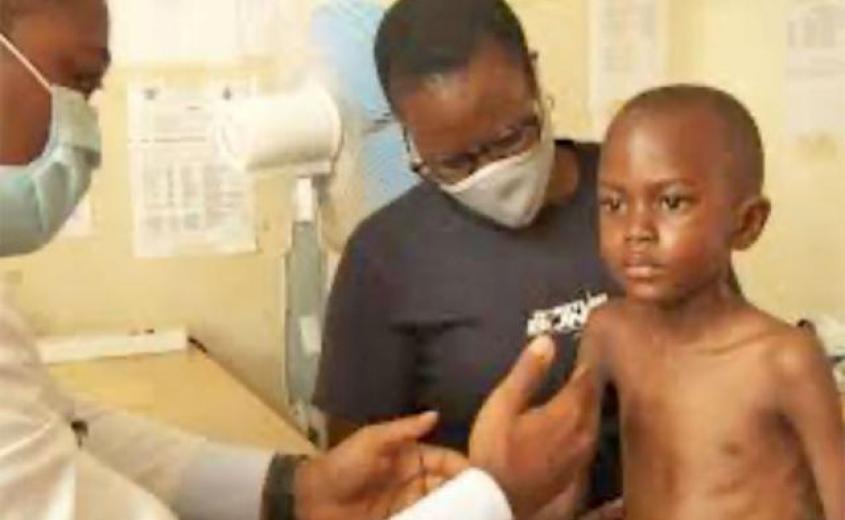Tuberculosis: MSF Launches Project to Tackle Underdiagnosis Among Children

It is estimated that in every three minutes a child dies of tuberculosis and more than half of all children with TB in Africa go undiagnosed.
Experts say tuberculosis (TB) in children is a silent scourge hence the new set of recommendations by the World Health Organisation (WHO), is timely towards its diagnosis among children. "Recent WHO recommendations on the diagnosis of TB in children can be a game changer to increase the number of children diagnosed and put on correct treatment”, says Cathy Hewison, head of MSF's tuberculosis working group.
Medicins Sans Frontiers (MSF) / Doctors Without Borders has launched a worldwide project aiming to increase the number of children diagnosed with TB as well as improve their treatment experience and prevent new cases. The initiative “TACTiC" for “Test, Avoid, Cure Tuberculosis in Children” will support projects in implementing these new WHO recommendations in countries in Africa and Asia.
The project, according to Cathy Hewison- head of MSF TB working group, says it aimed at contributing to knowledge-building through several multi-country studies on the validity and feasibility of the recommendations, while advocating for their widespread implementation and the development of better tools to diagnose TB in children.
Our initial experiences in pilot projects have shown the number of children diagnosed with TB can increase five-fold with the introduction of these new recommendations. However, the new recommendations are not yet widely put into practice so there is a lot of work to do, Cathy added.
TB in Children: The Chilling Facts
According to MSF 96 per cent of children who die from TB do not receive appropriate treatment1. It stated that the reason for this underdiagnosis of TB among children is multifactorial.
Among these reasons are, clinicians and programs being reluctant to start a long treatment of TB in children without a test confirming the diagnosis.
Children often get sick with low levels of the bacteria that cause TB,yet the current tests available to diagnose TB are unable to confirm the presence of the disease-causing germs among children. The available tests have been developed for adults and it relies heavily on specimens such as sputum for the test, but this is difficult for most children to cough up, says the Eastern Africa Media manager, John Riaga.
“Additionally, the lack of human resources to screen for and diagnose TB in many primary healthcare facilities as well as lack of access to diagnostic tools such as X-rays and molecular tests has deepened the gap over the years” Riaga recounted.
Delays in the diagnosis of TB in children are common, and as children are most at risk of developing the most serious forms of TB, these delays are often fatal, Riaga intimated.
“Now with the TIC-TAC project, clinicians and TB programs are able to make the decision to treat TB in children using clinical signs and symptoms without relying on results of laboratory tests or X-rays if they are not available or when the test results are negative. The implementation of these simple treatment decision algorithms can help clinicians and national TB programmes diagnose and treat more children”.
Increasing the diagnosis of TB in children
The TACTiC project aims to help MSF projects and teams, particularly those not specialized in the management of tuberculosis, initiate the implementation of the new WHO recommendations and use their experience to foster further scale up within MSF and beyond.
“Of course, it would be preferable to have simple, reliable, inexpensive, and easily accessible diagnostic tests to detect TB in children”, says Hewison. “However, to date these do not exist,therefore we are also advocating for a massive increase in resources for research and development of new and adapted tests to diagnose TB in children”.
The MSF says beyond diagnosis: a patient-centered approach
TACTiC is not only about improving the diagnosis of TB in children but also about the treatment and prevention of TB in this vulnerable age group.
The WHO has recommended a patient-centered approach to TB treatment in children. Based on a points system from the assessment of a child's symptoms, the new recommendations enable early detection of the disease and rapid initiation of treatment.
It recommended that a short four-month course of treatment be initiated, effective against non-severe tuberculosis and using the same child-friendly formulations already widely available. The benefits for children and families of a treatment that is two months shorter can be an enormous relief, reducing travel costs and follow-up time, as well as of course improving the treatment experience for the child.
Children under five who live in close quarters with adults with TB are often infected and are at high risk to develop active TB disease. Despite improved access to TB preventive treatment (TPT) being a long-standing global objective, only one in two TB contacts aged under 5 have access to it.
The WHO has now made it easier to protect children in these circumstances from becoming sick, by recommending short three-month treatments for prevention in this vulnerable group.
Contributing to knowledge and implementation gaps,
Operational research led by MSF's team of epidemiologists, Epicenter, is set to conduct and assess the feasibility, acceptability, and performance of the treatment decision algorithms in the MSF’s operation communities.
Studies are already enrolling patients in five MSF projects since autumn 2023: in Maiduguri, Nigeria; Madarounfa, Niger; Conakry, Guinea; Malakal, South Sudan; and Mbarara, Uganda. These sites will make it possible to document any difficulties encountered in implementing the programme and to propose solutions when the project is rolled out in up to 25 other countries.
Training will be provided to MSF teams and their Ministry of Health and national TB programme partners on treatment decision algorithms, the interpretation of X-rays, the newly recommended use of stool samples, contact case finding and follow-up, and health promotion.
Using the experience of participating projects, a toolkit of materials adapted to settings where MSF and partners work will be developed. In addition, TACTiC will also participate in advocacy at global international, national, and local levels to speed up the implementation of existing recommendations and call for the development of more adapted diagnostic tools.
By sharing findings with the international community involved in TB, TACTiC strives to remove barriers to TB treatment for children, ultimately reducing the number of deaths among children with tuberculosis, improving their treatment experience and preventing more cases.


